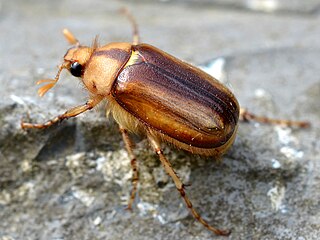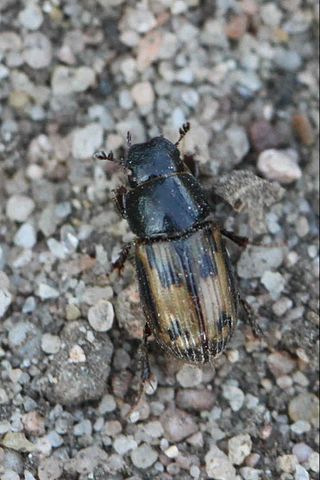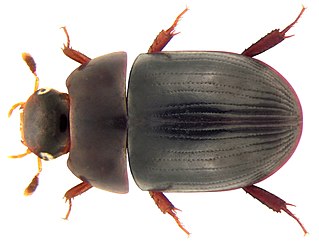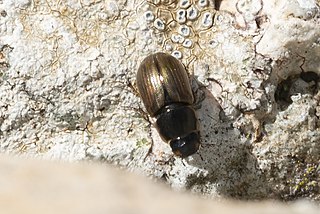
Flower chafers are a group of scarab beetles, comprising the subfamily Cetoniinae. Many species are diurnal and visit flowers for pollen and nectar, or to browse on the petals. Some species also feed on fruit. The group is also called fruit and flower chafers, flower beetles and flower scarabs. There are around 4,000 species, many of them still undescribed.

Cerambycinae is a subfamily of the longhorn beetle family (Cerambycidae). The subfamily has a world-wide distribution including: Asia, Europe and the Americas. Within the family, the only subfamily of comparable diversity is the Lamiinae.

Aphodius is a genus of beetles in the family Scarabaeidae. In most species both the adults and larvae are coprophagous although some species have herbivorous or saprophagous larvae. Aphodius species typically dominate dung beetle communities in north temperate ecosystems. Most species are functionally classified as endocoprids, also known as dwellers, because the larvae live and feed within the dung pat itself.

Onthophagus is a genus of dung beetles in the Onthophagini tribe of the wider scarab beetle family, Scarabaeidae. It is the most species-rich and widespread genus in the subfamily Scarabaeinae, with a global distribution.

Attagenus is a genus of beetles. This genus is found in tropical Africa, the Palearctic including Europe, the Near East, the Nearctic, North Africa and East Asia. There are nearly 200 species. The genus has existed for at least 99 million years, with fossils known from the Cenomanian aged Burmese amber and Turonian aged New Jersey amber.

Opsilia is a genus of beetles in the family Cerambycidae. It is listed as a subgenus of Phytoecia by some sources.

Stictoleptura is a genus of longhorn beetle in the family Cerambycidae.

Vesperus is a genus of beetles in the family Vesperidae.

Saperdini is a tribe of longhorn beetles of the subfamily Lamiinae.

Rhizotrogus is a genus of scarab beetles in the subfamily Melolonthinae.

Aphodiini is a tribe of aphodiine dung beetles in the family Scarabaeidae. There are more than 250 genera and 2,200 described species in Aphodiini.

Cetoniini is a tribe of fruit and flower chafers in the family of beetles known as Scarabaeidae. There are over 80 genera in Cetoniini.

Dactylosternum is a genus of water scavenger beetles in the family Hydrophilidae. There are more than 20 described species in Dactylosternum.

Sphaeriestes is a genus of narrow-waisted bark beetles in the family Salpingidae. There are about 13 described species in Sphaeriestes.

Coelophora is a genus of ladybird beetles in the family Coccinellidae. There are about 14 described species in Coelophora.

Oryctini is a tribe of beetles in the Dynastinae.

Chilothorax is a genus of scarab beetles in the family Scarabaeidae. There are more than 60 described species in Chilothorax, found in Europe, Asia, Africa, and North America.

Ammoecius is a genus of scarab beetles in the family Scarabaeidae. There are at least 20 described species in Ammoecius, found in Europe, Asia, and Africa.

Melinopterus is a genus of scarab beetles in the family Scarabaeidae. There are more than 20 described species in Melinopterus.



















